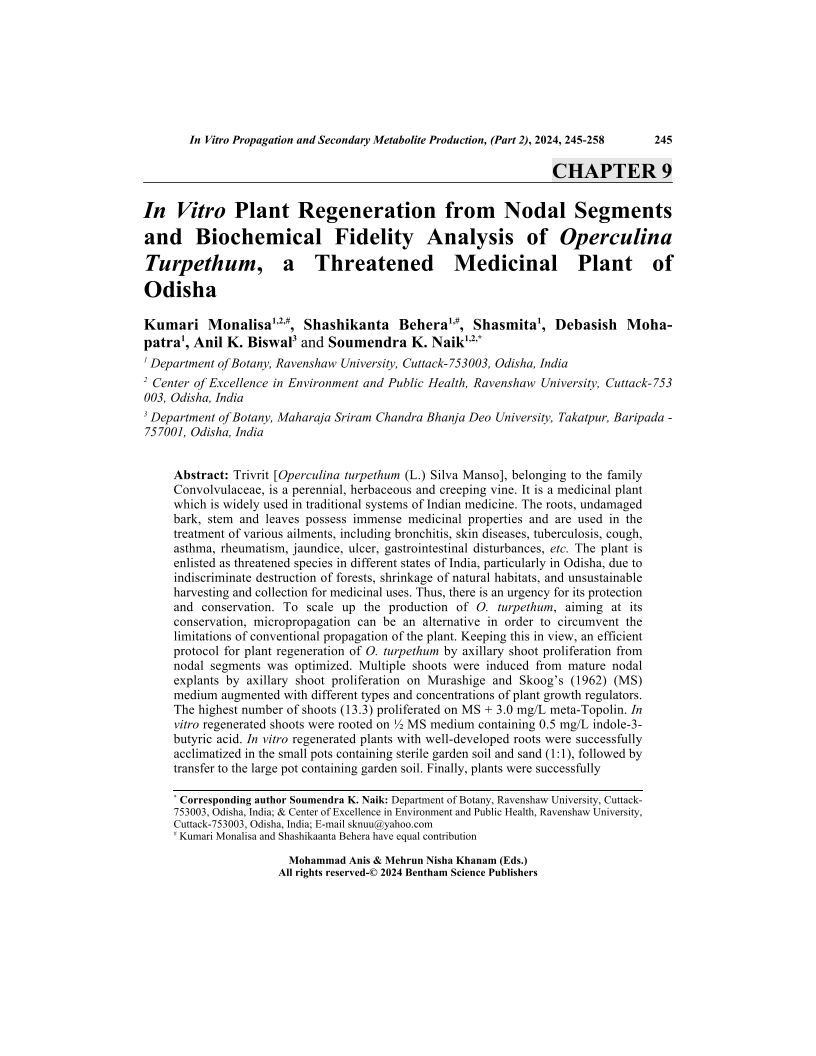- Home
- Books
- In Vitro Propagation and Secondary Metabolite Production from Medicinal Plants: Current Trends (Part 2)
- Chapter
In Vitro Plant Regeneration from Nodal Segments and Biochemical Fidelity Analysis of Operculina Turpethum, a Threatened Medicinal Plant of Odisha

- Authors: Kumari Monalisa1, Shashikanta Behera2, Shasmita3, Debasish Mohapatra4, Anil K. Biswal5, Soumendra K. Naik6
-
View Affiliations Hide AffiliationsAffiliations: 1 Department of Botany, Ravenshaw University, Cuttack 753003, Odisha, India 2 Department of Botany, Ravenshaw University, Cuttack-753003, Odisha, India 3 Department of Botany, Ravenshaw University, Cuttack-753003, Odisha, India 4 Department of Botany, Ravenshaw University, Cuttack-753003, Odisha, India 5 Department of Botany, Maharaja Sriram Chandra Bhanja Deo University, Takatpur, Baripada - 757001, Odisha, India 6 Department of Botany, Ravenshaw University, Cuttack-753003, Odisha, India
- Source: In Vitro Propagation and Secondary Metabolite Production from Medicinal Plants: Current Trends (Part 2) , pp 245-258
- Publication Date: April 2024
- Language: English
In Vitro Plant Regeneration from Nodal Segments and Biochemical Fidelity Analysis of Operculina Turpethum, a Threatened Medicinal Plant of Odisha, Page 1 of 1
< Previous page | Next page > /docserver/preview/fulltext/9789815196351/chapter-9-1.gif
Trivrit [Operculina turpethum (L.) Silva Manso], belonging to the family Convolvulaceae, is a perennial, herbaceous and creeping vine. It is a medicinal plant which is widely used in traditional systems of Indian medicine. The roots, undamaged bark, stem and leaves possess immense medicinal properties and are used in the treatment of various ailments, including bronchitis, skin diseases, tuberculosis, cough, asthma, rheumatism, jaundice, ulcer, gastrointestinal disturbances, etc. The plant is enlisted as threatened species in different states of India, particularly in Odisha, due to indiscriminate destruction of forests, shrinkage of natural habitats, and unsustainable harvesting and collection for medicinal uses. Thus, there is an urgency for its protection and conservation. To scale up the production of O. turpethum, aiming at its conservation, micropropagation can be an alternative in order to circumvent the limitations of conventional propagation of the plant. Keeping this in view, an efficient protocol for plant regeneration of O. turpethum by axillary shoot proliferation from nodal segments was optimized. Multiple shoots were induced from mature nodal explants by axillary shoot proliferation on Murashige and Skoogs (1962) (MS) medium augmented with different types and concentrations of plant growth regulators. The highest number of shoots (13.3) proliferated on MS + 3.0 mg/L meta-Topolin. In vitro regenerated shoots were rooted on ½ MS medium containing 0.5 mg/L indole-3- butyric acid. In vitro regenerated plants with well-developed roots were successfully acclimatized in the small pots containing sterile garden soil and sand (1:1), followed by transfer to the large pot containing garden soil. Finally, plants were successfully established in the field. The biochemical fidelity, in terms of secondary metabolites, was checked for tissue culture raised-field established plant vis-à-vis mother plant.
-
From This Site
/content/books/9789815196351.chapter-9dcterms_subject,pub_keyword-contentType:Journal105

